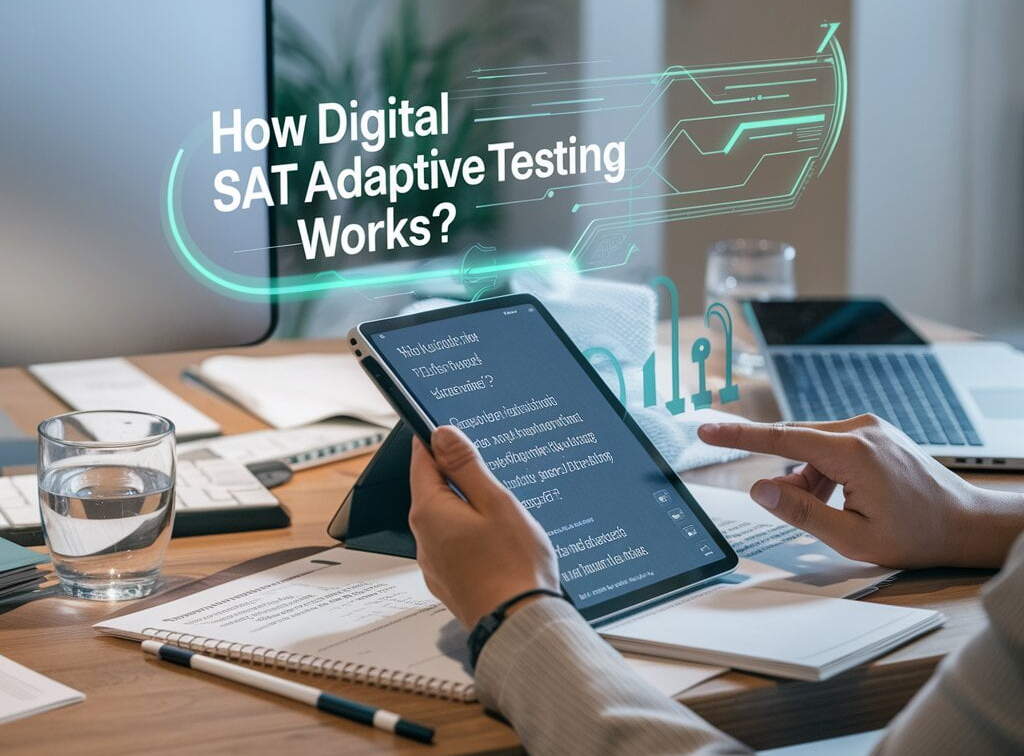Introduction
Unlike Digital SAT adaptive testing, the traditional SAT has long been a pivotal element in college admissions within the United States, serving as a standardized measure to evaluate a student’s readiness for college-level work. Over the years, the SAT has undergone several changes to better align with educational standards and technological advancements. One of the most significant recent changes is the shift from a traditional pen-and-paper format to a digital adaptive format. This evolution marks a significant milestone in the history of standardized testing, aiming to provide a more efficient, personalized, and accurate assessment experience.
Understanding Adaptive Testing
Adaptive testing represents a significant advancement in the field of educational assessments. Unlike traditional testing methods, which present a fixed set of questions to all test-takers, adaptive testing tailors the difficulty of questions to the individual abilities of each student. This personalized approach aims to create a more accurate and efficient testing experience.
Definition and Basics
Adaptive testing is a method of administering tests that dynamically adjusts the difficulty of questions based on the test-taker’s performance. As a student answers each question, the test algorithm evaluates their response and selects subsequent questions that are appropriately challenging. This real-time adaptation ensures that students are neither overwhelmed by questions that are too difficult nor bored by those that are too easy.
The core principle of adaptive testing is to hone in on a student’s true ability level more quickly and accurately than traditional testing methods. By presenting questions that are tailored to each student’s skill level, adaptive tests can provide a more precise measure of their knowledge and abilities.
Types of Adaptive Testing
There are several types of adaptive testing, each with its own methodology and application:
- Linear Adaptive Testing (LAT):
- In linear adaptive testing, the test is divided into several sections, each with a predetermined set of questions. The difficulty of each section is adjusted based on the test-taker’s performance in the previous section.
- While LAT offers some level of adaptability, it is less flexible than other adaptive testing methods because it does not adjust the difficulty of individual questions within a section.
- Multi-Stage Testing (MST):
- Multi-stage testing divides the test into a series of stages, with each stage consisting of a set of questions grouped into modules. The difficulty of each module is determined by the test-taker’s performance in previous stages.
- MST provides a balance between the flexibility of computer adaptive testing and the structure of linear testing. It allows for adjustments in difficulty at specific points during the test, rather than after each individual question.
- Computer Adaptive Testing (CAT):
- Computer adaptive testing is the most dynamic and responsive form of adaptive testing. In CAT, each question is selected based on the test-taker’s performance on previous questions. This continuous adjustment allows the test to quickly zero in on the student’s ability level.
- CAT is highly efficient, often requiring fewer questions to accurately assess a student’s abilities compared to traditional testing methods. This efficiency can reduce test-taking time and minimize test-taker fatigue.
- One of the key advantages of CAT is its precision. By continuously adapting to the test-taker’s performance, CAT can provide a detailed and accurate measure of their skills.
How Digital SAT Adaptive Testing Works
Structure of the Digital SAT
The Digital SAT adaptive testing has adopted MST model. The new digital SAT format is designed to be taken on a computer or tablet, and it maintains the core components of the traditional SAT, including sections on Reading, Writing and Language, and Math. However, the digital format allows for greater flexibility and adaptability and there are various reasons to take SAT even if it’s optional. The test is divided into several modules, and the difficulty of each module can be adjusted based on the test-taker’s performance in previous modules.
Key features of the digital SAT structure include:
- Modular Design: The test is divided into sections, each with a set of questions. The difficulty of each section can change dynamically based on the student’s performance.
- Timed Sections: Each section has a specific time limit, similar to the traditional SAT, ensuring that all students have a consistent testing experience.
- Interactive Interface: The digital format includes features like adjustable font sizes, highlighting tools, and the ability to flag questions for review.
Scoring Mechanism
The scoring mechanism for the digital SAT is designed to reflect the adaptive nature of the test while maintaining fairness and accuracy. Here’s how it works:
- Scaled Scoring: Scores are scaled to account for the varying difficulty of questions. This ensures that students are not penalized or unfairly advantaged based on the difficulty of the questions they receive.
- Performance-Based Scores: The final score is derived from the student’s performance across all sections. The adaptive algorithm considers the difficulty of the questions answered correctly and incorrectly to generate a comprehensive score.
- Score Reporting: Students receive a score report that includes their overall score, as well as detailed performance metrics for each section. This can help students understand their strengths and areas for improvement.

Conclusion
- Introduction to Digital SAT: The digital SAT is a modern iteration of the traditional SAT, designed to be taken on computers and utilizing adaptive testing technology.
- Understanding Adaptive Testing: Adaptive testing tailors question difficulty to the test-taker’s performance, providing a personalized and efficient assessment experience. Different types of adaptive testing, including linear, multi-stage, and computer adaptive testing, offer varying levels of adaptability.
- How Digital SAT Adaptive Testing Works: The digital SAT’s structure involves modular design, real-time question selection, and a precise scoring mechanism that scales scores based on question difficulty and student performance.
- Benefits of Adaptive Testing: Adaptive testing offers a personalized testing experience, efficient time management, and enhanced accuracy in assessing abilities, making it a superior method for evaluating student readiness.
- Challenges and Considerations: Technical issues such as system reliability, internet connectivity, and data security, along with student adaptation to the digital format, need to be addressed to ensure a smooth testing process.
- Tips for Preparing for the Digital SAT: Familiarizing with digital tools, practicing with adaptive test simulations, and managing test anxiety are crucial steps for students to effectively prepare for the digital SAT. As this is a new format, it is important to refer to the appropriate resources for Digital SAT Practice tests.
FAQs : Frequently Asked Questions
Q. How many digital SAT practice tests are there?
Six! As on July ’24, the College Board offers six official digital SAT practice tests through their online platform. These practice tests are designed to simulate the actual digital SAT experience, providing students with an opportunity to familiarize themselves with the test format, interface, and adaptive nature. Additionally, other test preparation companies and educational platforms may offer their own versions of digital SAT practice tests, expanding the number of practice resources available to students.
Q. Does Khan Academy have digital SAT practice tests?
Yes! Khan Academy has partnered with the College Board to offer free, official SAT practice tests, including digital SAT practice tests. Khan Academy provides a comprehensive suite of resources to help students prepare for the digital SAT, including full-length practice tests, interactive practice questions, and personalized study plans. These resources are accessible online and are designed to help students get accustomed to the digital format of the SAT.
Q. Are the digital SAT practice tests adaptive?
Yes! The official digital SAT practice tests provided by the College Board and available through Khan Academy are designed to mimic the adaptive nature of the actual digital SAT. These practice tests adjust the difficulty of questions based on the test-taker’s responses, providing a realistic practice experience. Practicing with these adaptive tests can help students understand how the test adapts to their performance and improve their test-taking strategies.
Q. Which digital SAT practice test is the easiest?
In general, the first few tests out of six are considered easy. However, there is no specific digital SAT practice test that is universally considered the easiest, as the adaptive nature of the tests means that the difficulty level is tailored to each student’s individual performance. However, some students may find certain practice tests more manageable based on their strengths and familiarity with the content. The key is to take multiple practice tests to get a well-rounded understanding of the test format and to identify areas where you may need additional practice. It’s also beneficial to review each test thoroughly to learn from any mistakes and improve your overall test-taking skills.
Q. Which Adaptive testing model is employed in Digital SAT?
MST! Digital SAT adaptive testing has adapted Multi-stage testing. It divides the test into a series of stages, with each stage consisting of a set of questions grouped into modules. The difficulty of each module is determined by the test-taker’s performance in previous stages.



